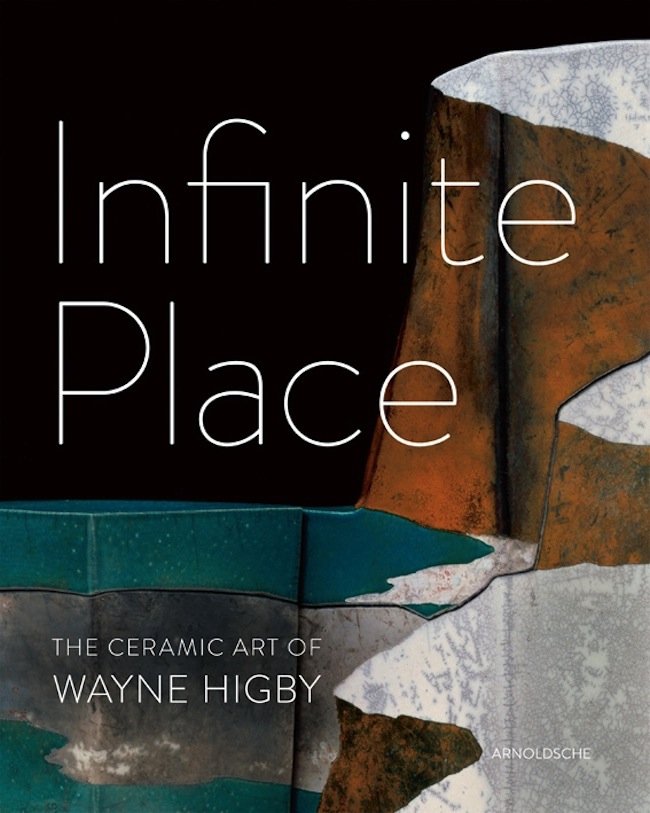Infinite Place: The Ceramic Art of Wayne Higby
Edited by Peter Held with contributions by Carla Coch, Helen W. Drutt English, Tanya Harrod, Wayne Higby, Mary Drach McInnes, Henry Sayre, and Ezra Shales
Arnoldsche Art Publishers, Stuttgart, Germany, 2013
Hardcover, 216 pages. 170 illustrations. 9.4 x 11.8 inches
Wayne Higby is widely considered one of the most innovative and influential artists to emerge from the post–World War II American ceramic studio movement. Infinite Place: The Ceramic Art of Wayne Higby documents how Higby became an international figure amongst contemporary ceramic artists through his work, travel, teaching, and critical writings. This book was edited by Peter Held, the Curator of Ceramics at the Ceramics Research Center in the Herberger Institute for Design and the Arts at ASU in Phoenix, Arizona. Held curated the eponymous exhibition that began at Arizona State University Art Museum, Tempe, Arizona (April 27 – July 20, 3013) and later traveled to the Smithsonian Museum (October 4, 2013 – December 8, 2013).
In the introduction of the book, Peter Held broached the topic of landscape in Higby’s work in this way:
Higby’s boxes, bowls, and sculptures have been widely interpreted as three-dimensional landscapes in the tradition of American landscape art—an interpretation the artist patently and repeatedly refutes. Like the nineteenth-century luminist painters of the Hudson River School whom Higby greatly admires, the artist engages landscape as ‘the panoramic outer membrane of an inner manifestation of unity—a silent, unseen, unknowable resonance of coherence.’
The book supplies images of Fredric Church, Thomas Cole, and Thomas Moran paintings that are so obviously in sympathy with the ceramic work that they make a very convincing case that Higby’s work is similarly metaphysical. However, the examples of landscape photography that Higby takes direct inspiration from are also instructive. This beginning prepares the reader for Higby’s passion for China and Asian aesthetic relationships to landscape that unfolds later in his career.
In the blockquote above, those are Higby’s words in quotes. His words are used extensively in the book’s essays (in addition to a text that he contributed titled Reflection), which is a testament to his scholarly contributions to the field of ceramic art. Erza Shales’ essay in particular goes into the nitty-gritty of the history of contemporary ceramic’s grappling with the question that is at the heart of contemporary ceramic practice, utility and craft vs. art objecthood. Higby was and is a major player in that conversation.
The book effortlessly leads the reader from Higby’s earliest raku pieces that are rather on the illustrative side to the relatively diminutive pieces that express a vast expansiveness. The latter pieces embody the “meditation on the relationship between spirit and matter” that Higby sought. After visiting China in 1991, Higby began using porcelain with celadon glazes and creating thick “rocks” that allude to the natural environment. During the last decade, Higby has undertaken several ambitious large-scale mural projects that include Skywell Falls (2009) and EarthCloud (2006), a panoramic interior installation that spans two adjacent art buildings at Alfred University. The installations are beautifully documented and, given Higby’s steadfast concerns and the monograph’s careful exposition, they feel like an inevitable evolution rather than a divergence.
Wayne Higby lives and works in Alfred, New York and holds a professorship and the Robert C. Turner Chair of Ceramic Art at Alfred University. Born in Colorado Springs, Colorado, Wayne Higby received a B.F.A. from the University of Colorado at Boulder, in 1966, and an M.F.A. from the University of Michigan, Ann Arbor, in 1968. He is the recipient of the American Craft Movement Visionary Award from the Museum of Arts and Design, New York, as well as the Master of the Medium award and the Distinguished Educator award from the James Renwick Alliance. Higby is also Honorary Professor of Art at Shanghai University and an Honorary Citizen of the “Porcelain City” of Jingdezhen, China. Higby is the founding director of the Alfred–Central Academy of Fine Arts’ Ceramic Design for Industry program in Beijing.
Amy Albracht is the General Editor at CFile.


Spreads from Infinite Place: The Ceramic Art of Wayne Higby from Arnoldsche Art Publishers, Stuttgart, Germany.
Visit the exhibition Infinite Place: The Ceramic Art of Wayne Higby at the Smithsonian

Add your valued opinion to this post.